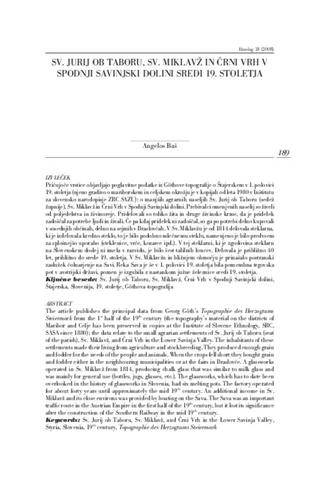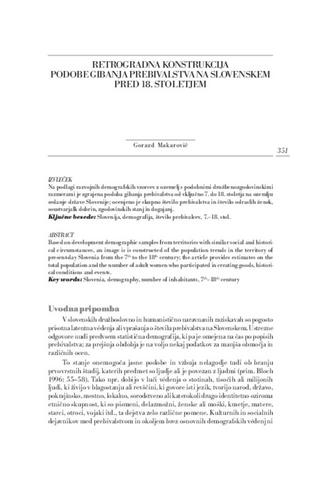Slovenski etnografski muzej
The article outlines the activities of museums around the world and in Europe during the covid-19
The article addresses the concept, functionality, types, and meanings of verbal salutations in di
The article addresses different food practices and food substitutes, in particular from the First
The article deals with beggars in Slovenia in the second half of the 19 th and early 20 th centur
The article presents the activities related to UNESCO's Convention for the Safeguarding of the In
The article describes humiliating punishments and humiliation devices in Slovenia from the Late M
The article publishes the principal data from Georg Göth's Topographie des Herzogtums Stei
The treatise addresses the following questions: what are may branches, maypoles and St George fes
The article deals with beggars in Slovenia in the second half of the 19th and early 20th centurie
Salutations are various conventional messages upon someone's arrival or departure, or when meetin
The article talks about the first decade of the appearance in Slovenia of Grandfather Frost (1948
Unlike other cultural phenomena, the food of Europe’s populations is a poorly researched area of
Slovenia ratified UNESCO's Convention for the Safeguarding the Intangible Cultural Heritage
Based on healing invocations recorded in the 19th and first half of the 20th centuries, the artic
The article presents New Year's tree celebrations accompanied by the arrival of Father Frost afte
The article presents the activities of Slovene folklore ensembles in the diaspora, analyzes the c
Adelma von Vay (1840-1925) was a baroness, who lived in Slovenske Konjice from 1867 onwards.
The article presents the use of Palm Sunday bundles in the Slovene countryside.
This essay takes two different cases – Žiga Kariž’s Terror = Décor project which occupied the Slo
The slovene protestant Catechism, written by Primož Trubar and published in Tübingen in 1575, amo
The author establishes that many ideas, methods and techniques belonging to alternative medicine,
Using photographs from the album of Terezija Barkovič, née Novoselič, the article presents the me
The article presents the memories of 1941-1945 war period as told by four people and is illustrat
The article presents an anthropological study of local representations of the changes in a cultur
The article brings a survey of the material on folk medicine, which was collected by the field te
Based on documentary material the article presents the memories of the 1941-1945 period, related
The article presents the life and work of the priest Jurij Humar (1819–1890).
Based on development demographic samples from territories with similar social and historical circ
The author tackles the subject of the generally only marginally treated transport of the deceased
The paper deals with the documented gravestone inscriptions from two aspects.
Placing the development of the kozolec in the framework of actual historical circumstances shows
Baroness Maria Wambolt lived at Hmeljnik Castle near Novo Mesto from 1876 to 1915.
In his analysis of the most significant texts written by staff members of the Carniolan Provincia
The article outlines the life and work of Dr. Marija Makarovič.
The article describes people`s attitude to health, illness and death in the individual periods of
The article deals with the use of the (auto)biographical method in Slovene ethnology , focusing o
The position of a woman in the Bizeljsko and Kozjansko regions in the first half of the 20th cent
The article presents and analyses the data which were collected, using, ethnological questionnair






































